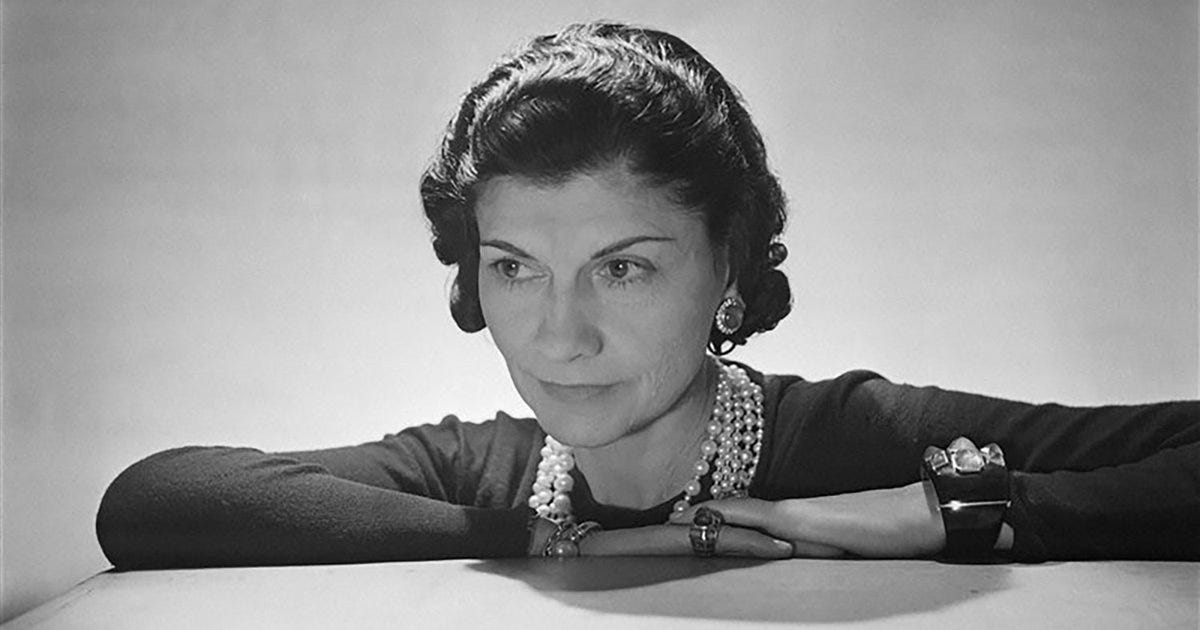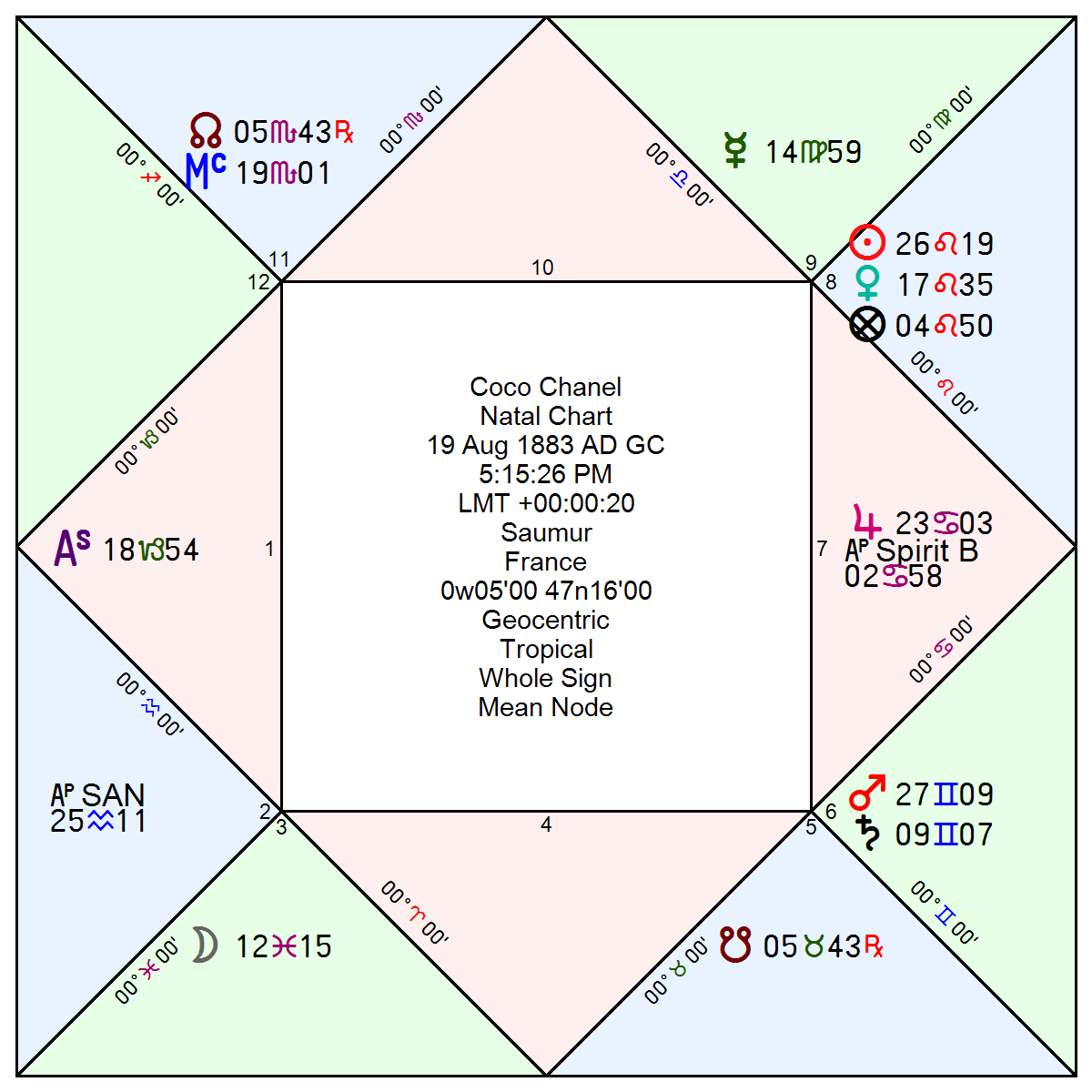With Jupiter in Cancer now traversing its own bound (19°–26° Cancer, Sept 7–Nov 11, 2025), it’s time for a full-throated embrace of Jupiter in its exaltation. For Coco Chanel, Jupiter in Cancer in the 7th (the public, partnerships) stands in mutual reception with the Moon in Pisces in the 3rd (message, movement, promotion). The combination turns perfume into atmosphere + myth—a perfect fit for Chanel No. 5, first presented on the fifth day of the fifth month in 1921 (timed, as I argue in the member-only rectification writeup, by an Ascendant→Moon solar-arc contact). Pisces/Cancer is aqueous, enveloping; Jupiter’s dignity in Cancer makes the feeling big, protective, nostalgic, while Moon-in-Pisces gives it a diffusive, dreamlike drift. In a creator, that’s the knack for making a scent that feels like a memory—and, thanks to Jupiter, scaling that feeling to the mass market. (Mutual reception is the easy conduit between mood and market.)
Not everything in her story is luminous. Saturn supplies the austere code—Aubazine black, edited line, the discipline behind the little black dress—even as the Moon separates from Saturn’s bodily harms (corsetry’s illness). Mars in Gemini in the 6th casts the shadow: the attrition of friends and the wartime entanglements that stained her name under Vichy. The Moon’s Configuration traces that arc—liberation, message, amplification, and reckoning—and today’s post follows it through.
Gabrielle Bonheur “Coco” Chanel was born August 19, 1883 in Saumur to an itinerant street vendor and a laundress. After her mother’s death (1895), she spent austere teenage years at the Aubazine orphanage, where she learned sewing—a discipline that imprinted the pared-back, monastic code she later turned into fashion language. A short stint as a café singer yielded the nickname “Coco.” By the 1900s she had entered elite social circles as the companion of Étienne Balsan and, crucially, Arthur “Boy” Capel, who financed her early ventures. She opened a Paris millinery in 1910, then boutiques in Deauville and Biarritz, dressing a wartime clientele that embraced her jersey separates, sailor stripes, and the radical comfort of clothes without corsetry. In the 1920s, she translated her aesthetic into scent with Chanel No. 5—an aldehydic abstraction that, with the Wertheimer partnership, became a global franchise—and into a uniform for modernity: the little black dress, ropes of faux pearls, two-tone shoes, and soft jackets that telegraphed ease over display.
The private life tracked—and often powered—the career. Capel’s death in a 1919 car crash left a lasting wound; Chanel never married but moved in powerful circles (the Duke of Westminster, Grand Duke Dmitri, artists from Stravinsky to Cocteau and Diaghilev). At the outbreak of World War II she shuttered the couture house (1939) and lived at the Ritz in occupied Paris. Her wartime conduct has drawn sustained scrutiny: a liaison with German officer Hans Günther von Dincklage; involvement in Operation Modellhut–style back-channel efforts; and an attempt to exploit Aryanization statutes to wrest control of No. 5 from the Wertheimers (foiled by their pre-war legal repositioning). Arrested after the Liberation, she was released within hours and decamped to Switzerland for nearly a decade.
Chanel’s late career was a second act few manage. In 1954—at 71—she reopened, pushing the tweed suit, quilted shoulder bag, chain belts, and a gentler silhouette that eventually resonated in postwar America even as Paris critics sniffed. She worked almost to the end, dying January 10, 1971 in Paris. The brand she founded became a juggernaut under later stewards, but the woman remains contested: an inventor of modern chic whose wartime record complicates the triumphal narrative.
Reputation—revisited in recent scholarship
In the last decade, writers have re-interrogated Chanel’s Nazi entanglements. Anne de Courcy’s Chanel’s Riviera (2019/2020) situates Chanel’s life on the Côte d’Azur against the rise of fascism and wartime occupation, addressing her anti-Semitism and collaboration while charting how glamour coexisted with opportunism and survival tactics. The book underscores how tightly her social world overlapped with Vichy/occupier privilege and how post-war mythmaking softened those edges. (Earlier, Hal Vaughan’s Sleeping with the Enemy (2011) was pivotal in surfacing archival evidence of her intelligence ties and legal maneuvers around No. 5, setting the terms of the debate that later works reprise.
Bottom line: Chanel refashioned women’s dress for the 20th century and built a brand-logic—minimal line, maximal symbolism—that still defines luxury. But the wartime ledger remains indelible: the same strategic instincts that made a modern aesthetic also enabled compromises with power that continue to tarnish the legend.
ADB Rodden Rating AA, BC/BR in hand, 4:00 PM, ASC 29SA41
Proposed Rectification: 5:15:26 PM, ASC 18CP54’17”
Complete biographical chronology and time lord studies available in Excel format as a paid subscriber benefit.
Victor Model factors favoring Venus in Leo
Bound Lord of Ascendant
Angular from Lot of Fortune (same sign)
Approaching superior conjunction with the Sun, received by the Sun
Physigonomy model factors favoring Capricorn, Taurus
Capricorn (rising sign): Shape of face is ovate with a prominent chin
Taurus (rising decan): Described by her friend Collete as a ‘black bull’ for complete quote see subscriber only rectification details
Moon’s Configuration: Moon separates from Saturn and applies to Mercury, Jupiter, and Mars
The aspect sequence is as follows:
1. Moon in Pisces: separates from square of Saturn
2. Moon in Pisces: applies to opposition of Mercury
3. Moon in Pisces: applies to trine of Jupiter
4. Moon in Pisces: applies to square of Mars
Special configurations: Moon is in the house of her joy. Moon/Pisces and Jupiter/Cancer are in mutual reception by sign rulership. There are no void-of-source conditions. There are no out-of-sign aspects.
Phase I — Moon Separates from Saturn (Gemini, 6th Whole Sign; 5th by Quadrant)
Delineation. Saturn in Gemini represents restriction and binding; in the 6th house it points toward illness and bodily harm. Corsetry, with its displacement of organs, respiratory compromise, muscular atrophy, and health damage, exemplifies this symbolism — fashion as a discipline that sickens. In the 5th by quadrant, Saturn also limits play and recreation: women were excluded from sport and free movement because their bodies were trussed in bone and steel. The Moon’s separation from Saturn, therefore, signals liberation from fashion’s literal illness and from restrictions on women’s participation in leisure and active life.
Biographical match. Chanel’s career begins with this act of release: abolishing the corset, cutting away the trussed female silhouette, and replacing it with jersey separates, sailor stripes, dropped waists, and the little black dress. This was not just style but reform of the body’s health. She freed women to walk, breathe, and move. The Moon’s separation from Saturn also speaks to her departure from Aubazine, the convent school whose black austerity imprinted her vision. And here a paradox enters: Saturn is 11 signs from the Lot of Fortune in Leo in the 8th, the place of acquisition. Although the Moon moves away from Saturn’s constraints, Saturn still supplies her fortune. The black, the restraint, the discipline of Aubazine became the Chanel palette and aesthetic code. She left Saturn’s harms but monetized Saturn’s discipline, turning uniform into brand.
Phase II — Moon Applies to Mercury (Virgo, 9th House, Bound of Venus)
Delineation. Mercury in Virgo is dignified, sharp, and discriminating. In the 9th house, Mercury governs publishing, advertising, and the codification of law. In the bound of Venus, its skills are channeled into Venusian domains: fashion, beauty, perfume. This is Mercury not as “writer” but as market-maker: precise communication, images, copy, and contracts that establish a brand and disseminate it across borders.
Biographical match. Because the Moon applies to Mercury before Jupiter, the sequence shows that Chanel’s message and market identity coalesced before her partnerships scaled it. Indeed, her boutiques and her 1921 launch of Chanel No. 5 show Mercury’s power: advertising that turned products into myths, minimalist packaging, striking ad copy. Mercury in Virgo in Venus’s bound also manifests in the legal dimension: the contracts and lawsuits with the Wertheimers over Parfums Chanel. The careful detail of Mercury, applied in the 9th, created both her market voice and her legal battles. Mercury was thus the hinge that carried Chanel from Saturn’s bodily liberation into the realm of myth and commerce.
Phase III — Moon Applies to Trine of Jupiter (Cancer, 7th House)
Delineation. Jupiter in Cancer is exalted, and in the 7th it signifies partnerships, contracts, and the public. In mutual reception with the Moon in Pisces, the trine is a powerful circuit: emotional resonance (Moon) expanded and distributed (Jupiter). This aspect promises alliances that magnify personal creation into cultural institution.
Biographical match. After Mercury established Chanel’s myth, Jupiter provided scale. The Wertheimer partnership of 1924 is the clearest expression: Parfums Chanel was the vehicle through which No. 5 went global. Jupiter in the 7th gave her distribution networks, capital, and reach. Chanel’s moods, scents, and fashions could be broadcast across continents because Jupiter received them. The sequencing is critical: Mercury (advertising, myth) first; then Jupiter (partnership, scale). Chanel did not build her legend on Jupiter’s patronage alone — she had already articulated her brand through Mercury. Jupiter then magnified what Mercury had made.
Phase IV — Moon Applies to Square of Mars (Gemini, 6th House)
Delineation. Mars in Gemini in the 6th shows combative speech, duplicity, and entanglement in low or dangerous company. As ruler of the 11th house of friends, Mars in the 6th is the 8th from the 11th: the death of friends. The Moon’s eventual square to Mars points to both personal loss and political compromise.
Biographical match. Chanel’s later years were marked by loss: the deaths of Arthur Capel, Sergei Diaghilev, Hugh Grosvenor, and others left her isolated. Mars in Gemini also ties to her wartime entanglements: her relationship with Hans Günther von Dincklage and suspected Nazi collaboration. Mars here is the shadow of the chart: friends lost, reputation tarnished, the duplicity of fashion icon and suspected spy. The Moon’s final square marks the decline after Jupiter’s triumph: Chanel’s brand endured, but her personal story was shadowed by conflict and loss.
Interpretive Summary
Chanel’s Moon moves from Saturn to Mercury to Jupiter, and finally to Mars. First, the Moon separates from Saturn in Gemini in the 6th: a release from restrictive corsetry that harmed women’s health, and from the social constraint that excluded them from free activity. Yet Saturn, in the place of acquisition relative to Fortune, still profited her: the black, restraint, and discipline of Aubazine became her aesthetic code. Chanel left Saturn’s harms but turned Saturn’s austerity into fortune.
Next, the Moon applies to Mercury in Virgo in the 9th, in the bound of Venus. Here she finds her market voice: advertising, myth, and contracts. Mercury comes before Jupiter in the sequence, which means Chanel’s brand identity and message cohered before she gained the partnership that would scale it. The minimalist imagery of No. 5, the sharp copy, and even the legal maneuvers against the Wertheimers all belong here.
Then, the Moon trines Jupiter exalted in Cancer in the 7th, completing a mutual reception by sign. This brought the partnerships — above all the Wertheimers — that amplified her myth worldwide. Mercury made the story; Jupiter broadcast it. This sequencing shows why Chanel could become a global legend: myth first, then distribution.
Finally, the Moon squares Mars in Gemini in the 6th. This marked the shadow years: the deaths of friends and patrons, the duplicity of wartime entanglement with Nazi intelligence, the stain on her reputation. The Moon’s final contact shows decline, loss, and conflict, even as the brand she created endured.
In sum: Chanel’s Moon moves from illness and restriction (Saturn) → message and advertising (Mercury) → partnership and global scale (Jupiter) → loss and duplicity (Mars). It is the story of a woman who left Saturn’s constraints, profited from Saturn’s discipline, mythologized Venus through Mercury, scaled her legend through Jupiter, and ended under Mars’s shadow.
AI Notice: ChatGPT contributed to this article.
Keep reading with a 7-day free trial
Subscribe to House of Wisdom to keep reading this post and get 7 days of free access to the full post archives.



